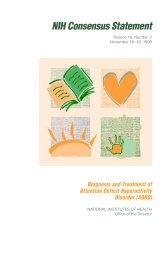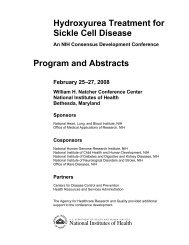Celiac Disease - NIH Consensus Development Program - National ...
Celiac Disease - NIH Consensus Development Program - National ...
Celiac Disease - NIH Consensus Development Program - National ...
Create successful ePaper yourself
Turn your PDF publications into a flip-book with our unique Google optimized e-Paper software.
Should Adults Be Screened for <strong>Celiac</strong> <strong>Disease</strong>? What Are the Benefits and Harms of Screening? Pekka Collin, M.D., Ph.D.Recent epidemiological studies have shown that the prevalence of celiac disease (CD) isas high as 1 percent in both the United States and in Europe. (1,2) The prevalence of detecteddisease is much lower, from 0.27 percent to 0.02 percent. (3,4) This means that for every patientwith a diagnosis of CD, 3–10 patients with CD remain undetected. Symptoms of the disorder arediverse, and the disease is often asymptomatic. (1,2) Without active serologic screening, most casesof CD may remain undiagnosed. Recent serologic screening assays, especially the IgA-classtissue transglutaminase antibody test, are sufficiently inexpensive, sensitive, and specific toallow even mass screening for CD. The disease satisfies the criteria for mass screening andtheoretically there are many standpoints favoring such an approach. CD is associated with manysevere complications that can be prevented by gluten-free dietary treatment. The questionremains whether we should apply screening to all adults or only to certain risk groups.The risk of small-intestinal lymphoma is increased in CD. (5) In retrospective andcross-sectional studies, dietary treatment has been shown to prevent the malignantdevelopment. (6) However, there is no evidence as yet to suggest that patients with mild or onlysubtle symptoms run an increased risk of lymphoma. There is, in fact, indirect evidence to thecontrary; undetected CD has not proved a significant factor in the etiology of lymphoma. (7) Somecases may be detected by severe neurological disorders such as ataxia, without any symptomsindicative of CD. (8) However, such complications are rare and prevention of neurologicalsequelae does not justify mass screening.Screening has been advocated in order to prevent malabsorption. Again, the evidence isscarce. Subclinical osteoporosis occurs in undetected patients with CD, even in asymptomaticsubjects. (9,10) The prevention of osteoporosis seems to be the strongest indicator for widespreadscreening today. It has also been hypothesized that early gluten-free dietary treatment mightprevent the development of autoimmune conditions in CD. (11) The issue is controversial, (12) anddoes not therefore justify mass screening.Screening asymptomatic individuals for CD may be harmful. A lifelong gluten-free dietis not easy to maintain, and the subject’s quality of life may deteriorate. It is also debatablewhether patients found by active screening adhere to a gluten-free diet similarly to symptomaticones. In type 1 diabetes, it may be problematic to combine a diabetic and a celiac diet. Whether agluten-free diet is of benefit or harm in celiac patients without symptoms and malabsorption isthus controversial. Screening is also costly; apart from serologic testing, even a small loss ofspecificity will result in numerous “useless” endoscopies. Compulsory testing would also entailethical problems.CD is a common disorder with a specific treatment. Increased alertness should beobserved in at-risk patients. Serologic screening should be applied in individuals with evensubtle indicative symptoms such as subclinical isolated iron deficiency. In various autoimmuneconditions the risk of CD is approximately 5 percent, (13) and in individuals with affectedfirst-degree relatives, 15 percent. Infertility, neurological symptoms such as polyneuropathia,83







